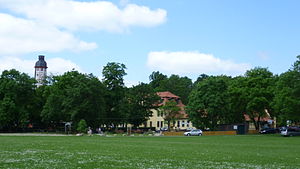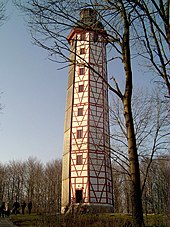Antics (Sondershausen)
| Antics | ||
|---|---|---|
|
View of the hunting lodge and the Possenturm from the southeast |
||
| height | 431.5 m above sea level NHN | |
| location | Thuringia ( Germany ) | |
| Mountains | Hainleite | |
| Coordinates | 51 ° 20 '20 " N , 10 ° 51' 29" E | |
|
|
||
| rock | Shell limestone | |
| particularities |
|
|
The antics is 431.5 m above sea level. NHN high mountain of the Hainleite in the Thuringian Kyffhäuserkreis with a viewing tower ( Possenturm ) and a listed ensemble of buildings and a park from the 18th and 19th centuries on the plateau to the southeast. It is located about four kilometers south of Sondershausen .
Surname
The origin of the name Possen is not clearly documented. Hence, there are innumerable interpretations. They range from the personal name "Pozzo" to a constantly repeated legend about a member of the Princely House who is said to have spoken about the new hunting lodge using the word antics . The name "Zum Possen" first appeared in 1738 after the hunting lodge was converted.
An etymological derivation of the word in connection with the time of its appearance can provide an explanation. Based on the early New High German "posse, bosse", meaning "ornaments, accessories", borrowed from the old French "boce", a change in meaning occurred in the 16th century in the sense of "joke, funny prank". On a map of Sondershausen from 1783 you can find the name Bossen . This resulted in the verb “bossieren, fussing” in the meaning “being funny, joking, doing antics”. It can therefore be assumed that the name “Zum Possen” was chosen for the renovated hunting lodge in 1738 to simply designate a place where - in contrast to court etiquette - one could be funny, joke and do all sorts of antics. The name of the hunting lodge was then shortened to describe the area around this house. The hallway "Vogelgesang" changed its name to "Antics".
history
With the year 1670 a hunting lodge with the name "Zum neue Jagdhaus auf dem Oberspierschen Forste" is mentioned in documents. With this name it must be assumed that there was an older house before that. Due to structural changes between 1732 and 1738, Prince Günther XLIII. von Schwarzburg-Sondershausen prompted another name change. Until 1737 the building was called "Jagdschloss auf dem Vogelgesang", a year later, when the renovation work was completed, it was named "Zum Possen". The residential and farm buildings were expanded from 1760 to 1762. This house was used by the Oberspier Forestry Office from 1828 onwards . The dethroned Prince Günther Friedrich Carl I found a place to stay here from 1835 to 1837.
From 1867 horse breeding was resumed. The water supply was a constant problem. The water was fetched in barrels by a team of horses from the upper spar fountain, which is 700 m northeast. Under Prince Günther Friedrich Carl II (reigned 1835–1880) the riding hall, the game reserve (for deer and birds) and a bear pen were built. At this time, the preparations for the construction of the Possenturm began. The uncultivated area was turned into a park with historical routes, lines of sight and extensive meadows. After the Prince's abdication in 1918, the property became the property of the State of Thuringia .
In the mid-1960s, the area was expanded to become a local recreation center. From 1976 to 1979 a cottage settlement and a restaurant were built south of the Possenturm. Company sports festivals, equestrian sports and music events were held on the large lawns. In the last few years of the GDR , the installation of an anti-aircraft missile system was still planned on the antics. After the fall of the Wall , the antics remained a popular excursion destination in Northern Thuringia and is now called the "amusement park".
Current usage
According to the tenant, the antics is visited annually by 120,000 to 150,000 people. Events such as dog shows take place on the grounds of the “Possen Leisure and Recreation Park” .
building
Hunting lodge
The hunting lodge is a four-wing complex around a closed courtyard with farm and residential buildings made of plastered timber framing . The main building has a gabled central risalit on the south side , which carries a coat of arms, a sundial and trophy sculptures . This decoration was made around 1890. The two-storey main building is covered by a mansard roof. Inside, the baroque room structure is still preserved on the upper floor. The former court kitchen was in the east wing. Below are the cellars. Otherwise the main building does not have a basement.
Riding arena
With the resumption of horse breeding in 1867, a riding hall became necessary. This is an octagonal building, just like the Possenturm and the octagonal house (1707) in Sondershausen on the Schlossberg. The flat pyramid roof consists of eight side triangles. A hall ceiling was missing. It was only withdrawn in 1967 to save energy. During the Second World War the hall served as a prisoner of war camp. After the reconstruction in 1967 the riding arena became the "Ringcafé". The weather vane on the top of the roof bears the imperial double-headed eagle . It can be found in the coat of arms of the Schwarzburger after they were raised to the rank of imperial prince in 1697 . The connection building to the riding stables is used today as a restaurant. The riding hall itself is now a leisure hall with the possibility of playing billiards and table tennis.
Poss tower
The Possenturm ( Lage ) is considered the oldest and highest observation tower in Europe, which was built in half-timbered houses. The observation tower was built in 1781 within 11 months and stands on a stone base. The tower height measures 42.18 m. It also served as a landmark when surveying the Schwarzburger Land. Hikers could also see the Possenturm from the highest mountain in the Harz, the Brocken , from the “tower of the inn”, “partly with, partly without a telescope”: If you “turn to the right […] the ruins of Kyffhausen Castle in the golden floodplain , the Possenthurm near Sondershausen, the Ettersberg near Weimar, ”says Friedrich Gottschalck in the paperback for travelers to the Harz in 1823 .
The visitor reaches the viewing platform above the tower hood via 214 steps. The octagonal, eight-storey half-timbered building has a late baroque, cantilevered tail hood with a viewing platform and lantern. The floors taper towards the top. Each has four windows, one according to the cardinal points. Originally the viewing platform was open. It was closed by windows during the Second World War and served as an aerial observation post.
The clock attached to the new building was moved to the Sondershäuser Schlossturm in 1786. The first renovation of the tower was necessary in 1867. From 1951 the Possenturm was closed to visitors. In the lower part of the tower, load-bearing parts of the timber framework were so destroyed that the tower began to tilt and its stability was no longer guaranteed. He threatened to collapse or overturn. By means of a campaign "Save the Tower Poss" under the "were National Construction work " of the GDR with the help of committed citizens and with donations from the population 1958/59 carried out the most important safety work, thus protecting the tower from decay. After further work, u. a. The installation of sheet metal cladding on the weather side enabled the tower to be reopened to visitors in 1966 after an almost 15-year ban.
Fungal and bacterial infestation later developed under the sheet metal cladding, so that in 2002 the tower had to be closed to visitors again due to the acute danger of collapse. Through the construction work that followed until 2004, the tower was renovated, stabilized and given a new paint job. The corrugated iron has been replaced by a well-ventilated weather protection shell made from larch boards.
Bear kennel
The bear pen was also created during the re-design phase of the Possen after 1867. It is a round tower open at the top with a crenellated crown. Four cave-like rooms on the south side served as feed and bear chambers. The young bears were fetched from a hunting area in the Carpathian Mountains by the princes of the royal court in 1867 after three mother animals had been killed. The animals from the bear tower, which is still completely preserved today, were relocated to a new cage elsewhere during the GDR era. After protests by animal rights activists, it was expanded in 1998. Three brown bears now live in an enclosure that complies with (today's) legal requirements.
Game gate
The game reserve was built in the second half of the 19th century. Today fallow deer , red deer , mouflon , wild and pot-bellied pigs , horses, ponies, donkeys, sheep and goats can be observed on a spacious area .
The aviaries with pheasants and other bird species were replaced in 2011 by a house for meerkats and falcons. Furthermore, there has recently been the Australian corner, where emus and dwarf kangaroos can be seen.
There is a pet area south of the parking lot.
Show fountain
When a drinking water pipeline to Oberspier was built in 1976/77, an old well was found during the earthworks. It was built in 1761/62 and had been forgotten. It was 38 m deep. Two more wells were dug. One was at today's playground (1858, 46 m deep), another was south of the riding hall (1922, 14 m deep). In 1987 the oldest well was reconstructed on behalf of the preservation authorities. The roof and the fountain parapet are modeled as the original design is not known.
Individual evidence
- ↑ a b Map services of the Federal Agency for Nature Conservation ( information )
- ↑ Statement as of 2007
- ↑ http://www.possen.de/jagdschloss-historie.html
- ^ Magdeburg: Heinrichshofen, 1823 from G.Ch. Keil, pp. 115-116; SUB Göttingen 8HGERMI, 250
- ↑ Ulrich Kühn: Save the Possenturm. Blog post, January 18, 2011
literature
- Etymological dictionary of German . Akademie-Verlag, Berlin 1989, p. 1303
- Architectural guide GDR, district of Erfurt , VEB Verlag für Bauwesen, Berlin 1979.
- Günther Lutze: Communications from the Association for German History and Archeology in Sondershausen , Sondershausen, Issue 6, 1921.
- Edmund Döring: Messages of the association for German history and antiquity in Sondershausen . 6th issue, Sondershausen 1931.
- Monument registration Kyffhäuserkreis . Thuringian State Office for Monument Preservation, Erfurt 1998.
Web links
- Website of the amusement and recreation park antics
- Christiane Rossner: "Sehlust" on the Possenstein. Contribution to the Possenturm at Monumente Online, May 2007







